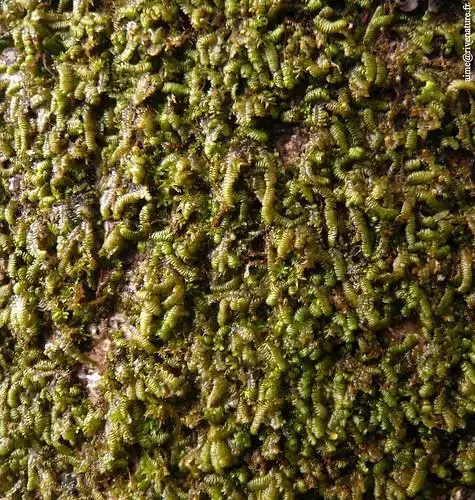
medium.jpg from: https://www.inaturalist.org/guide_taxa/509502
Introduction
Nestled within the intricate tapestry of nature lies a fascinating world of bryophytes, a group of non-vascular plants that includes mosses, liverworts, and hornworts. Among these diminutive yet captivating organisms is the Frullania nisquallensis Sull., a moss species belonging to the Frullaniaceae family, commonly known as Frullania. This unassuming plant holds a wealth of secrets waiting to be uncovered by the curious minds of enthusiasts.
Background
Before delving into the intricacies of Frullania nisquallensis Sull., it’s essential to understand its place within the broader context of bryophytes. These ancient plants, classified under the division Marchantiophyta and class Jungermanniopsida, have existed on Earth for over 400 million years, predating even the earliest vascular plants. Despite their small stature, bryophytes play a crucial role in various ecosystems, acting as pioneers in colonizing new environments and contributing to soil formation and water retention.
Main Content
Morphology and Identification
Frullania nisquallensis Sull. is a leafy liverwort that forms intricate, flattened mats or cushions on the surfaces it inhabits. Its delicate leaves are arranged in two rows along the stem, each leaf divided into two lobes – an upper lobe and a lower lobe. The upper lobe is typically larger and more rounded, while the lower lobe is smaller and often folded against the stem. This distinctive leaf arrangement is a hallmark of the Frullania genus.

8586249667_1bd24caf47_b.jpg from: https://www.flickr.com/photos/chaerea/8586249667
One of the most striking features of F. nisquallensis is its vibrant coloration. The plant can range from deep shades of green to reddish-brown, depending on its environment and growth stage. This chameleon-like ability to adapt its pigmentation is a fascinating adaptation that helps the moss thrive in various light conditions.

8557917451_9d43dedc93_z.jpg from: https://flickr.com/photos/chaerea/8557917451

49874161013_e8f4bc3246_b.jpg from: https://www.flickr.com/photos/98938839@N07/49874161013/
Global Distribution and Habitat
Frullania nisquallensis Sull. is widely distributed across the Pacific Northwest region of North America, extending from British Columbia in Canada to California in the United States. It is particularly abundant in the moist, temperate rainforests of the Cascade and Coast mountain ranges, where it thrives on the bark of trees, rocks, and decaying logs.
This moss prefers shaded, humid environments and is often found in old-growth forests or areas with high moisture levels. Its ability to absorb and retain water from the surrounding air makes it well-suited to these damp habitats, where it plays a vital role in maintaining the delicate balance of the ecosystem.
Ecological Roles and Adaptations
Despite its diminutive size, Frullania nisquallensis Sull. plays a crucial role in the ecosystems it inhabits. As a pioneer species, it is one of the first organisms to colonize bare surfaces, paving the way for other plants and facilitating the establishment of more complex communities.
One of the remarkable adaptations of F. nisquallensis is its ability to reproduce both sexually and asexually. This versatility ensures the species’ survival and propagation in a wide range of environmental conditions. Additionally, the moss possesses specialized structures called

49874695096_e73c9870aa_b.jpg from: https://www.flickr.com/photos/98938839@N07/49874695096/
gemmae cups, which produce tiny, multicellular propagules known as gemmae. These gemmae can detach from the parent plant and disperse through wind or water, allowing the moss to colonize new areas and expand its range.
Case Studies/Examples
In the temperate rainforests of the Pacific Northwest, Frullania nisquallensis Sull. is often found growing in close association with other bryophyte species, such as the feather moss Hylocomium splendens and the leafy liverwort Porella navicularis. This intricate mosaic of bryophytes creates a microhabitat that supports a diverse array of invertebrates, fungi, and other microorganisms, contributing to the overall biodiversity of the ecosystem.
Technical Table

48297865097_d5e8d3acff.jpg from: https://www.flickr.com/photos/182520580@N04/48297865097/

48297888207_8a98ee1c95_b.jpg from: https://www.flickr.com/photos/182520580@N04/48297888207/

84070.jpg from: https://www.calflora.org/app/taxon?crn=14415

large.jpg from: https://www.inaturalist.org/guide_taxa/1386618

2153317_orig.jpg from: https://www.centralcoastbiodiversity.org/hanging-millipede-liverwort-bull-frullania-tamarisci-ssp-nisquallensis.html
| Characteristic | Description |
|---|---|
| Scientific Name | Frullania nisquallensis Sull. |
| Family | Frullaniaceae |
| Common Name | Frullania |
| Division | Marchantiophyta |
| Class | Jungermanniopsida |
| Growth Form | Leafy liverwort, forming mats or cushions |
| Leaf Arrangement | Two rows, each leaf divided into an upper and lower lobe |
| Coloration | Deep green to reddish-brown |
| Reproduction | Sexual and asexual (via gemmae) |
| Habitat | Moist, temperate rainforests, on bark, rocks, and decaying logs |
| Distribution | Pacific Northwest region of North America |
Conclusion
Frullania nisquallensis Sull., a humble yet remarkable moss species, serves as a testament to the incredible diversity and resilience of bryophytes. Its intricate morphology, adaptations, and ecological roles highlight the intricate web of life that exists even in the smallest of organisms. As we continue to explore and appreciate the wonders of nature, perhaps we can ponder this thought-provoking question: What other secrets lie hidden within the diminutive world of mosses, waiting to be uncovered by the curious minds of enthusiasts?